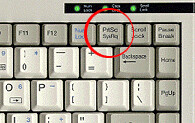 Often abbreviated Prt Scr, the Print Screen key is a useful key supported on most PCs. In DOS, pressing the Print Screen key causes the computer to send whatever images and text are currently on the display screen to the printer. Some graphics programs and Windows, use the Print Screen key to obtain Screen Captures.
Often abbreviated Prt Scr, the Print Screen key is a useful key supported on most PCs. In DOS, pressing the Print Screen key causes the computer to send whatever images and text are currently on the display screen to the printer. Some graphics programs and Windows, use the Print Screen key to obtain Screen Captures.1. Maximize the window you'd like to capture.
2. To copy/capture the current window, hold down ALT + Print Scrn at the same time. To capture the entire screen, just press Print Scrn.
3. Open a new document in MS Word, MS Photo Editor, or Adobe PhotoShop.
4. Paste the screen shot by holding down CTRL and V at the same time.
5. Print the document when you're finished pasting screen shots.
Macs prove more versatile because the screen captures are automatically saved as files in the PICT format - Apple's version of Microsoft's BMP. This file is created when one presses Command plus Shift plus 3. To save just the window you want, hold down Command plus Shift plus 4 plus caps lock. Now you can open any window and make a copy by holding down the Control key and clicking inside it.
Q How can I can disable the Print Screen function to prevent users from copying images to the clipboard?
A. Windows implements Print Screen using a registered hotkey. Windows uses the predefined hotkeys IDHOT_SNAPDESKTOP and IDHOT_SNAPWINDOW to handle Print Screen. These correspond to Print Screen, which captures the entire screen, and Alt+Print Screen, which captures only the active window. To disable these functions all you have to do is register the hotkeys, which causes Windows to send your app a WM_HOTKEY message when the user presses either hotkey. Your implementation can ignore the message to bypass the default screen-capture behavior. A good place to do it is in your mainframe class.
The ALT-PRINTSCREEN captures the active window. If you had a dialog box open and wanted that image only, ALT-PRINTSCREEN will only capture that part, while PRINTSCREEN captures the entire monitor screen's view. If there is only one window open (blue title bar at top), then ALT-PRINTSCREEN essentially does the same as PRINTSCREEN.
In Windows, you can capture only the active display by pressing Alt and the Prt Scr key. That key is usually to the right of the function keys at the top of the keyboard. Or, by pressing the Control key and Prt Scr, the entire screen showing the currently selected window and all other stuff can be acquired.
In either case, these moves create a file in the highly detailed BMP format, holding a pixel-by-pixel version of the page at the precise time the keys were pressed. The BMP file is held in the computer's memory, so one needs to paste it into some kind of a program that accepts photos, like the Paint program in Windows or flavors of Photoshop.
